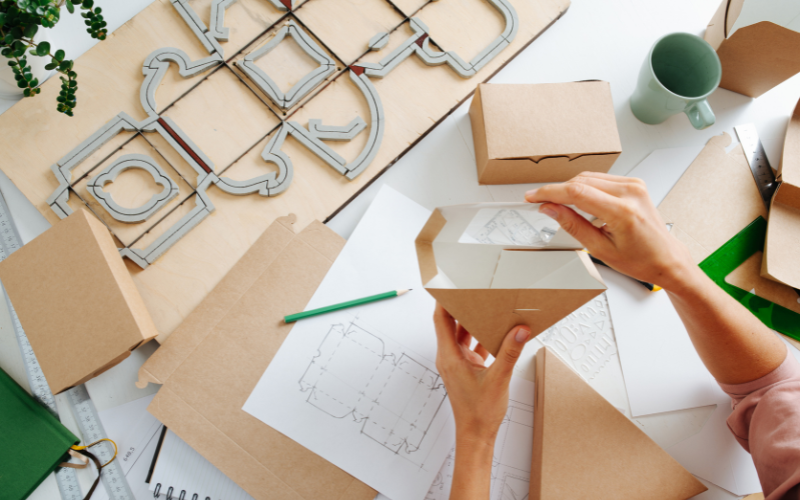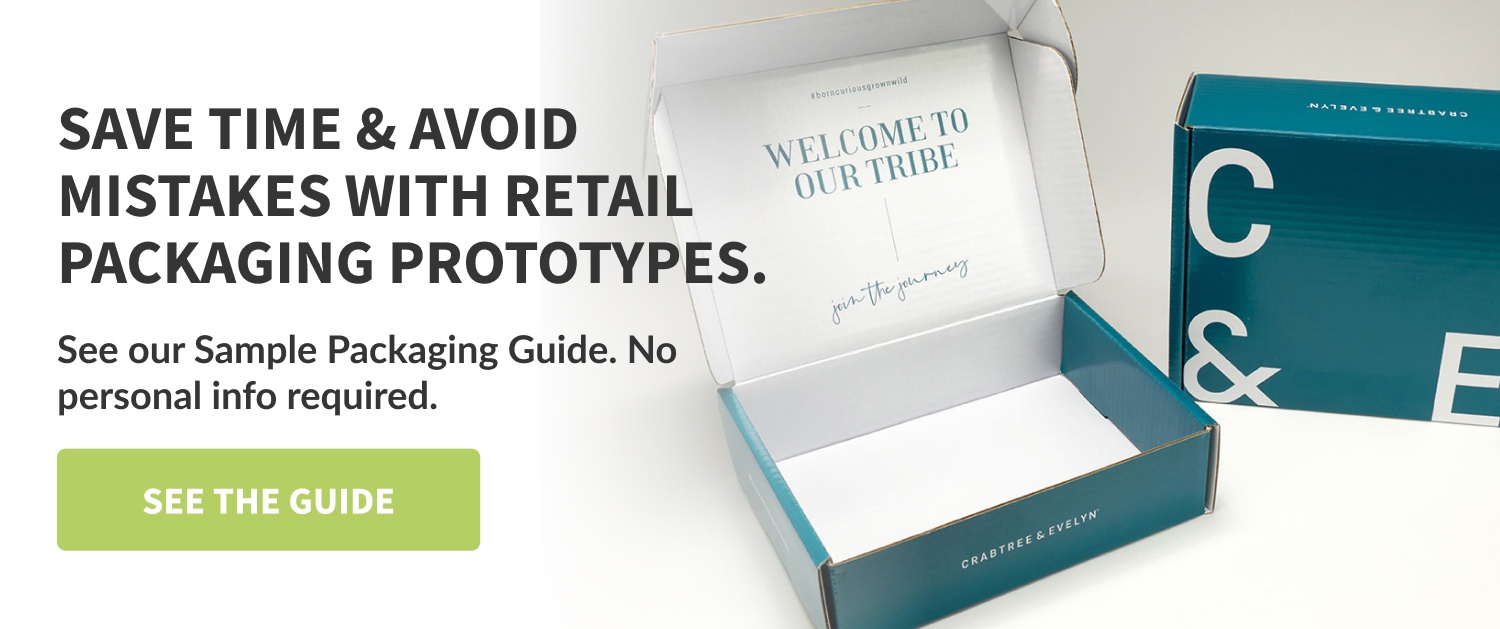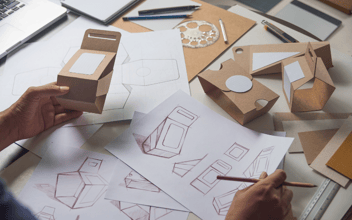Product Packaging Trends for 2023
In the fast-moving world of product packaging, it pays to stay ahead of the curve. Packaging only provides a small window of time to capture customers’ attention before they move on.
It’s vital to be aware of popular designs so you can keep up with competitors and attract new customers with visually striking packaging. Let’s explore the top ten packaging trends of 2023.
Bold Fonts
In the new year, expect to see leading brands using typography as the centerpiece of their packaging. Logos and artwork will still play an important role in advertising, but distinctive typography creates a lasting imprint in consumers’ minds.
Brands are decluttering their packaging and focusing on bold text and engaging language. Clean packaging is especially appropriate for cosmetics, food, and hardware. These industries attract customers who have definite criteria they’re looking for—like paraben-free, organic, or durability ratings.
Many leading brands naturally integrate bold fonts into their branding. For example, consider Etsy’s distinctive orange serif font. You can buy virtually any product on Etsy, but customers create a mental link between their favorite products and Etsy’s typographical logo.
Minimalism
Going hand-in-hand with bold fonts is the growing trend toward minimalism in product packaging. Consumers are overwhelmed and overstimulated these days and many people prefer packaging with clean lines, minimal colors, and straightforward text.
Psychologically, consumers associate minimalist packaging with transparency, so industries that rely on trust—like supplements and beauty products—should consider simplifying their packaging design. Many mail-order startups like Harry’s Razors use simplistic packaging that attracts customers without overwhelming them.
Sustainability
People are willing to pay more for eco-friendly products. In fact, 74% of customers are willing to pay more for sustainable packaging. Prove that you’re committed to the environment by avoiding single-use plastics, sourcing recycled and recyclable materials, and incorporating biodegradable elements in your packaging.
If you use sustainable materials in your packaging, make sure to highlight this information. Put your eco-bonafides front and center with messages like “100% post-consumer plastic,” “compostable,” and “I’m recyclable.”
Products with socially conscious buyers like health foods, cannabis, and outdoor gear should consider cleaning up their supply chains. Any investments you make in sustainable packaging will usually be offset by increased customer loyalty and boosted sales.
For example, Lush Cosmetics bolsters its vegan and cruelty-free image by using 100% post-consumer plastic and 86% post-consumer cardboard for its packaging.
Related Content: 10 Types of Eco-Friendly Packaging For Your Products
Colorful Palettes
Capture buyers’ attention from across a crowded store with visually engaging color palettes. Bright colors are especially popular for flavored products because color can augment the perceived flavor of snacks and soft drinks.
Any products catering to youth or the young at heart are a great fit for vibrant colors. For instance, Ella’s Kitchen—which makes fruit smoothies for children—uses a bright playful design to attract attention in the supermarket. When in doubt, order sample packaging and see if bright colors are a good fit for your brand image.
Tactile Texture
Textural packaging is a rising trend that includes embossing, debossing, die-cuts, and foil prints. Most customers associate textured packaging with high-end brands, meaning that you can boost your brand’s perceived value without changing your underlying products.
Using unique textures takes your packaging above and beyond the visual. When a consumer picks up your product, they will be more likely to buy it if it features a full sensory experience. Even adding a matte finish to your cardboard boxes can distinguish you from competitors.
Mascot Variations
We can all picture timeless brand mascots that have remained relatively unchanged for decades, like Tony the Tiger or the Michelin Man. These days, more brands are playing with slight variations on classic mascots. A small alteration in clothing or aesthetic can match a mascot more accurately with the product they are promoting.
Changing the public’s expectations can also renew a conversation about your products and modernize your image. For instance, M&M’s attempted to make their mascots more inclusive, which sparked a broader conversation about inclusivity in marketing.
Sticker Book Aesthetic
In an increasingly complicated world, consumers like nostalgic aesthetics that remind them of simpler times. One strategy is the “sticker book aesthetic” that emulates the carefree attitude of 90s sticker books.
This fun, youthful energy can be applied outside of the realm of children’s products. For instance, cosmetics brand Morphe collaborated with Lisa Frank to create unique and captivating 90s-themed packaging for its products.
70s Vintage
Another decade-related trend is nostalgia for vintage 70s aesthetics. Warm color schemes, wavy imagery, and rounded letters are making a comeback in clothing, home decor, and even packaging design.
Use a 70s aesthetic if you have a classic product that evokes the past. For instance, Fischer Audio’s “Oldskool” headphones complement their vintage look with classic packaging. Customers will respond to this thoughtful design that bolsters the overall brand image. Sample packaging is a good solution if you want to trial different artwork before settling on a final design.
Interactive
Packaging that encourages potential buyers to pull a product off a shelf and interact with it is much more likely to convert a sale. Simple packaging tricks like cut-outs and translucent windows entice consumers to engage with your products when they would normally walk past.
Consider Phillip’s Hue Lamp packaging, which uses a built-in color wheel to show the different colors available for each lamp. This fun feature gets consumers to pick the package off the shelf and also helps them picture the product in action. If your product is fun to operate, like a toy or kitchen tool, it might be a good idea to include an interactive element in your packaging.
Return-ready
Most products ship directly to consumers, leading to a high rate of returns. Industries like clothing and footwear rely on customers over-ordering and returning the items that don’t fit. Make returns easy for consumers by including return labels and packaging in their original order.
Although you may lose money in the short term when customers return your products, they will remember the convenience and be more likely to patronize your business in the future. For brands in the fashion industry, easy returns are a great feature that will convert into long-term sales and brand loyalty down the road.
Choosing a Packaging Design
Before you choose a final packaging design, it’s imperative to define your product and buyer persona. Conduct surveys with previous customers to get hard data on your key demographics and identify areas that need improvement.
Armed with this data, you can make informed packaging decisions and help boost sales. Use the following tips to design the perfect packaging.
Know Your Product and Your Customer
Consider which qualities of your product are most important to highlight. Then determine your target audience and promote the best attributes of your product in an eye-catching, engaging manner. For example, if you sell outdoors products to conscious consumers, you should focus on the environmentally friendly aspects of your product and packaging.
Research the Competition
A little friendly competition helps brands reach their full potential. Research your direct competitors and note the areas where you out-compete and under-compete them. Use your packaging to highlight your strengths and make note of your weaknesses so you can improve them and remain competitive.
It’s important to stand out from the crowd, but brands also need to know what’s working in the market. For instance, if your competitor offers free returns and easy-to-use return packaging, it might give them a leg up with customers. Consider adapting your policies and packaging to keep up with competitors. If you want to try different variations to improve your image, sample packaging is a great option.
Remember Your Brand Story
While designing your new product packaging, it's imperative to craft a strong brand narrative that everyday people can relate to. Maybe this has to do with your origin story, your values, or your community involvement.
Focus on your brand story throughout the packaging design process so consumers know exactly where you stand. Third-party certifications, like “organic,” “fair-trade,” or “100% recycled” can help corroborate your brand story and endear you to buyers.
Looking Forward to 2023
With these trends in mind, you can take your brand to the next level in 2023. Find design aesthetics that match your personality—from the 70s to the 90s, and from minimalist to interactive. More than following trends, the most important thing is to find packaging that represents your company accurately.
Working with a trusted product packaging company can help you with every step, from design to shipping and logistics.






